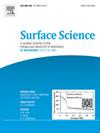Initial stage of silver overlayer formation on the Ni(110) surface
IF 1.8
4区 化学
Q3 CHEMISTRY, PHYSICAL
引用次数: 0
Abstract
Silver-induced surface atomic structures on a Ni(110) surface up to 1 ML between room temperature and 673 K were studied using ultrahigh vacuum scanning tunneling microscopy and low-energy electron diffraction. A 0.72 ML-Ag-deposited surface at room temperature showed monolayer-high aggregated Ag stripes separated by periodic trenches and shallow troughs. Ag stripes consisted of six aggregated Ag atoms in the direction to form a one-dimensional (1-D) cluster and it extended in the direction with 3 × 9 and surface superstructures. Some Ag stripes were bridged by fuzzy regions where 1-D fluctuating Ag atoms were adsorbed on the substrate Ni(110) row. Above 473 K, the 1-D Ag cluster consisting of seven atoms formed Ag stripes with periodicity of the surface unit cell in the direction, and the Ni(110) substrate surface was exposed between the Ag stripes. The stability of the Ag stripes was confirmed by conducting first principles calculations and through simulated STM images.

Ni(110)表面银层形成的初始阶段
利用超高真空扫描隧道显微镜和低能电子衍射技术,研究了室温至673 K温度下1ml Ni(110)表面的银致表面原子结构。室温下0.72 ml银沉积表面显示出由周期性沟和浅槽分隔的单层高团聚银条纹。银条纹由6个银原子沿[11 > 0]方向聚集而成,形成一维团簇,沿[001]方向延伸,表面超结构为3 × 9和30±19个。一些银条纹被模糊区桥接,其中一维波动的银原子被吸附在衬底Ni(110)上。在473 K以上,由7个原子组成的一维银簇在[11′0]方向上形成了具有12倍周期性的银条纹,Ni(110)衬底表面暴露在银条纹之间。通过第一性原理计算和模拟STM图像证实了银条纹的稳定性。
本文章由计算机程序翻译,如有差异,请以英文原文为准。
求助全文
约1分钟内获得全文
求助全文
来源期刊

Surface Science
化学-物理:凝聚态物理
CiteScore
3.30
自引率
5.30%
发文量
137
审稿时长
25 days
期刊介绍:
Surface Science is devoted to elucidating the fundamental aspects of chemistry and physics occurring at a wide range of surfaces and interfaces and to disseminating this knowledge fast. The journal welcomes a broad spectrum of topics, including but not limited to:
• model systems (e.g. in Ultra High Vacuum) under well-controlled reactive conditions
• nanoscale science and engineering, including manipulation of matter at the atomic/molecular scale and assembly phenomena
• reactivity of surfaces as related to various applied areas including heterogeneous catalysis, chemistry at electrified interfaces, and semiconductors functionalization
• phenomena at interfaces relevant to energy storage and conversion, and fuels production and utilization
• surface reactivity for environmental protection and pollution remediation
• interactions at surfaces of soft matter, including polymers and biomaterials.
Both experimental and theoretical work, including modeling, is within the scope of the journal. Work published in Surface Science reaches a wide readership, from chemistry and physics to biology and materials science and engineering, providing an excellent forum for cross-fertilization of ideas and broad dissemination of scientific discoveries.
 求助内容:
求助内容: 应助结果提醒方式:
应助结果提醒方式:


